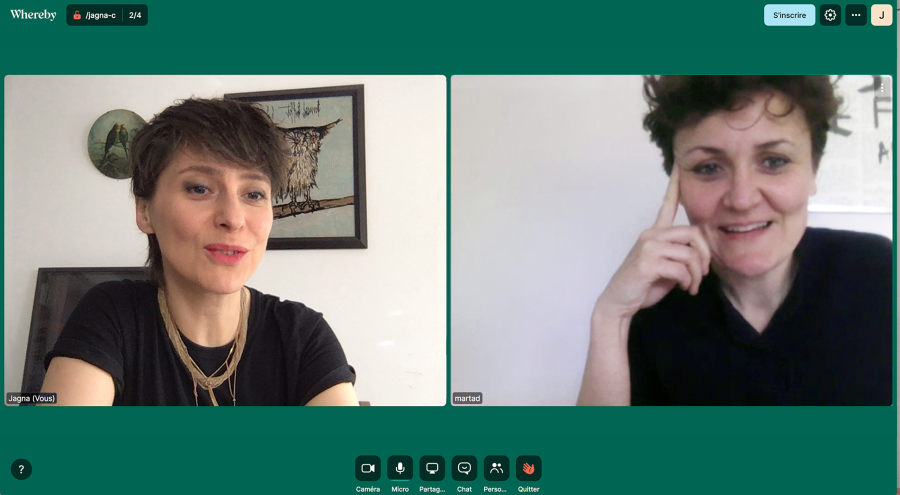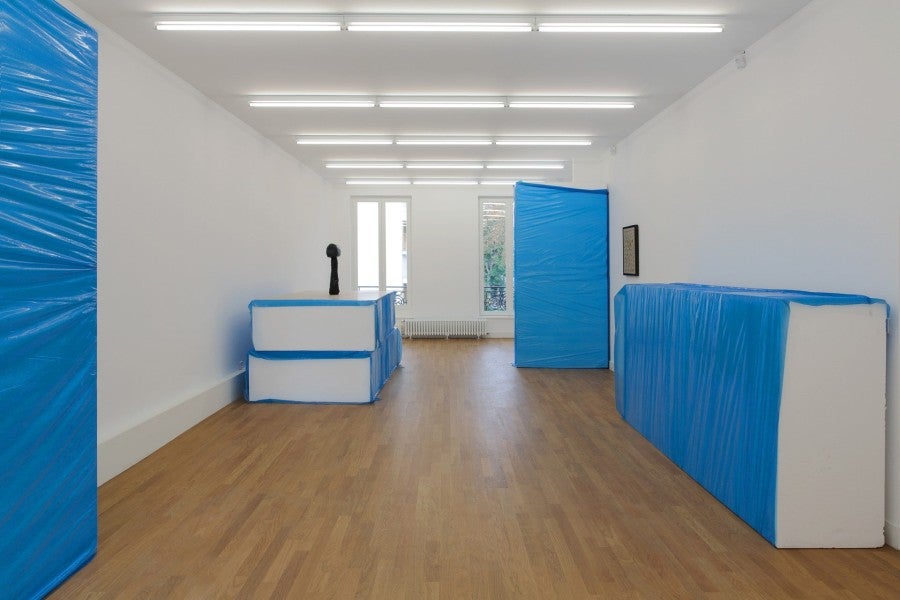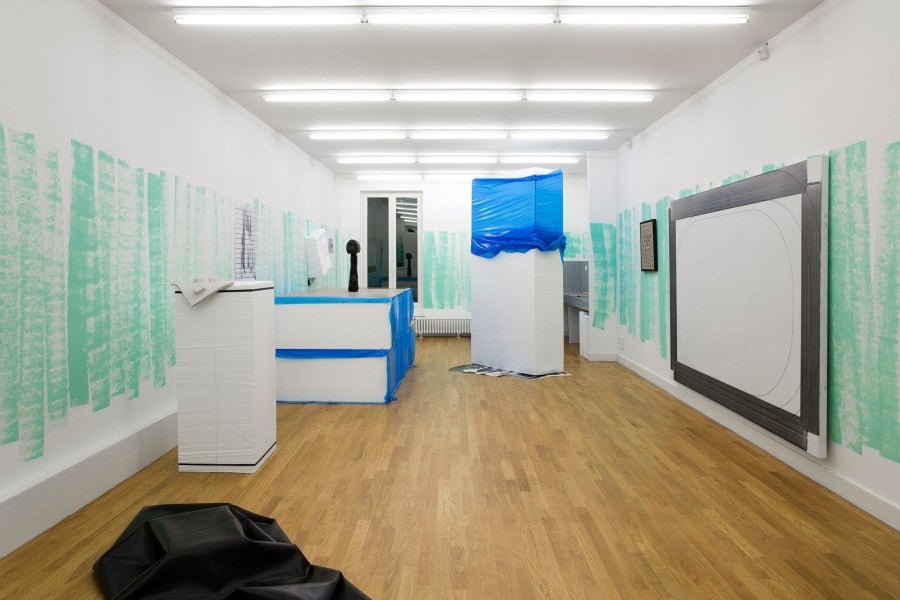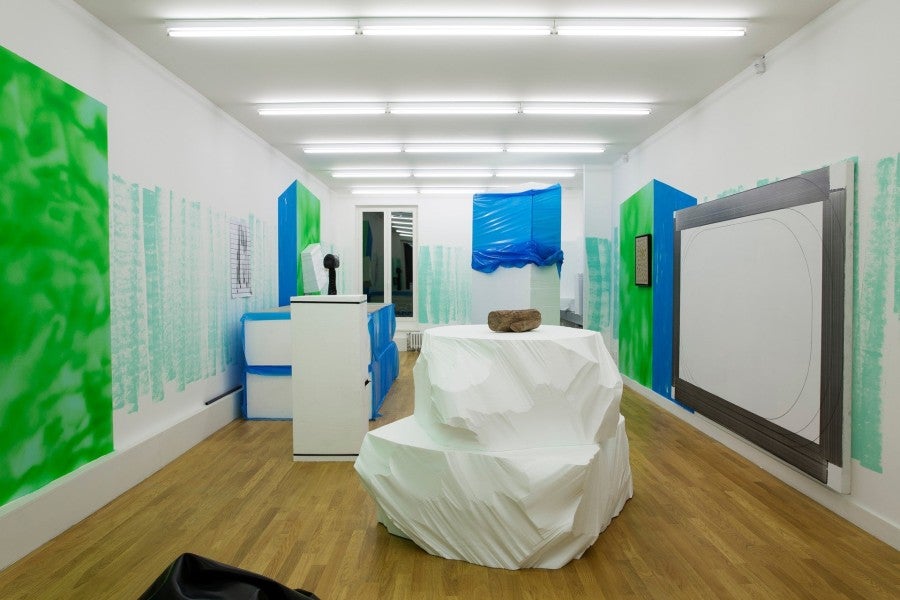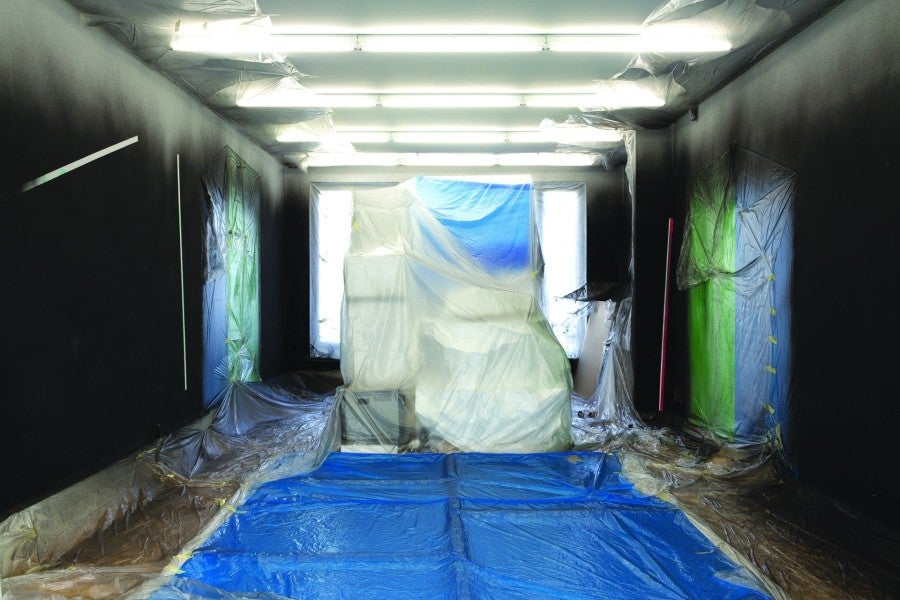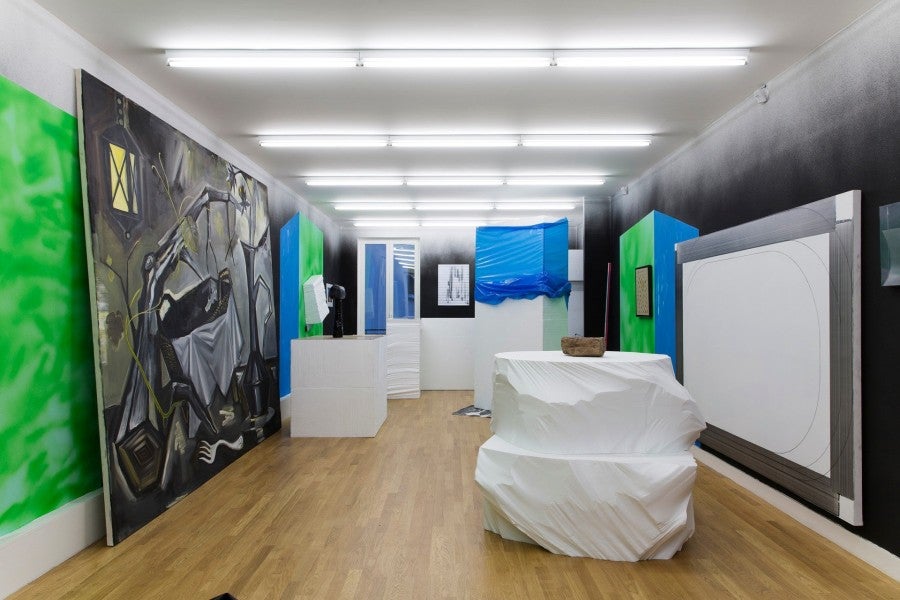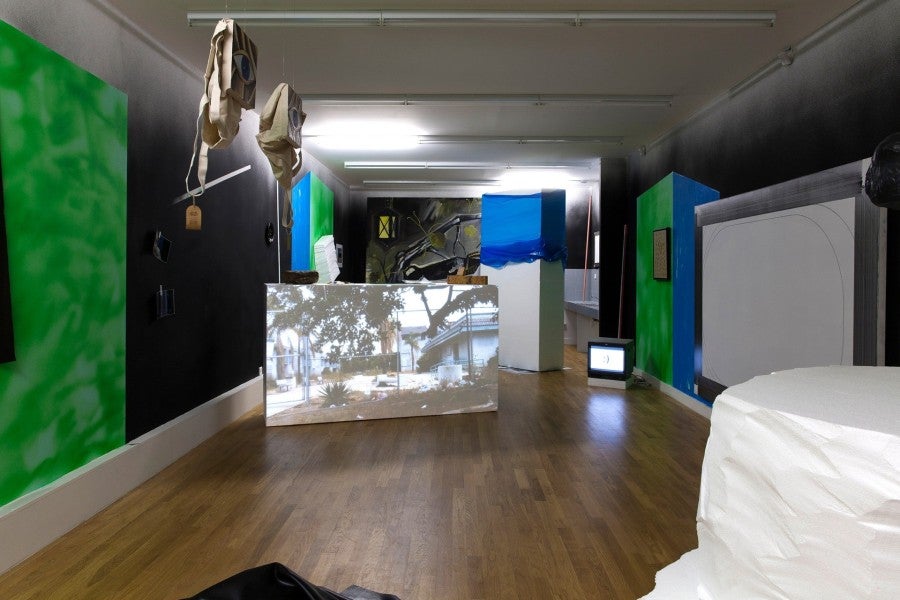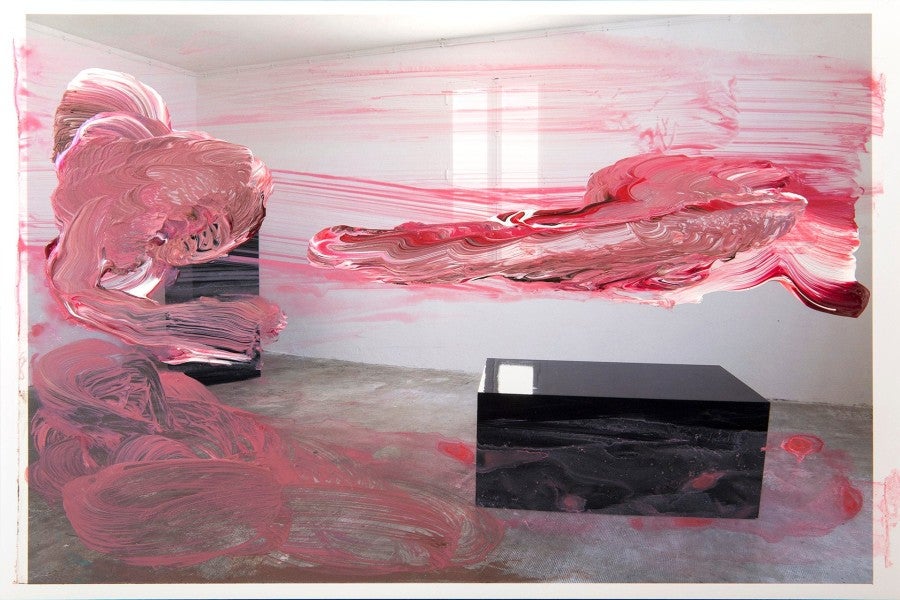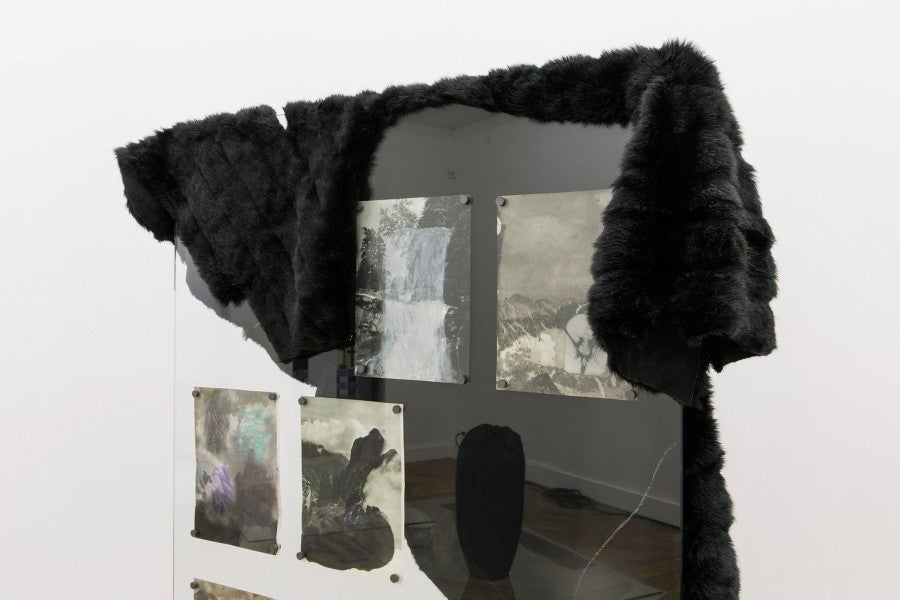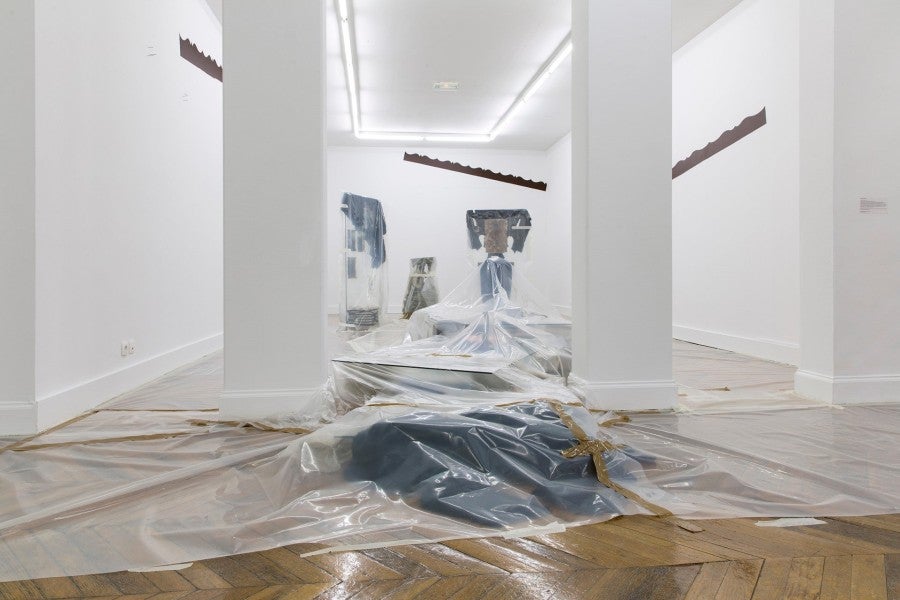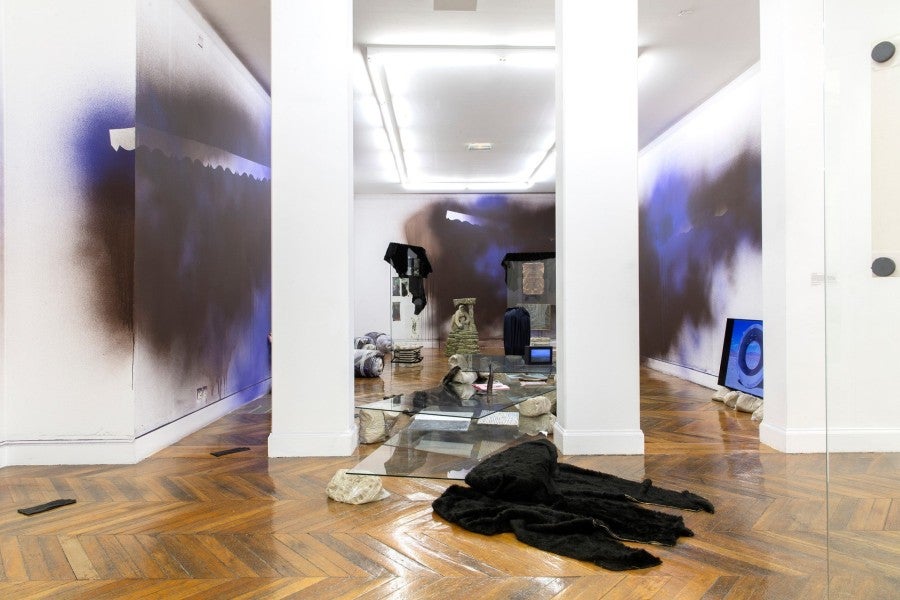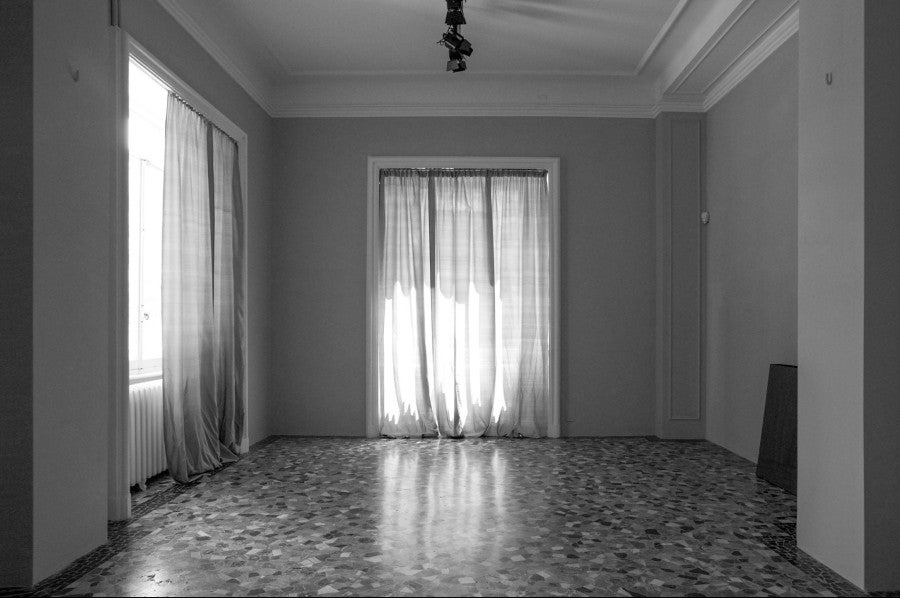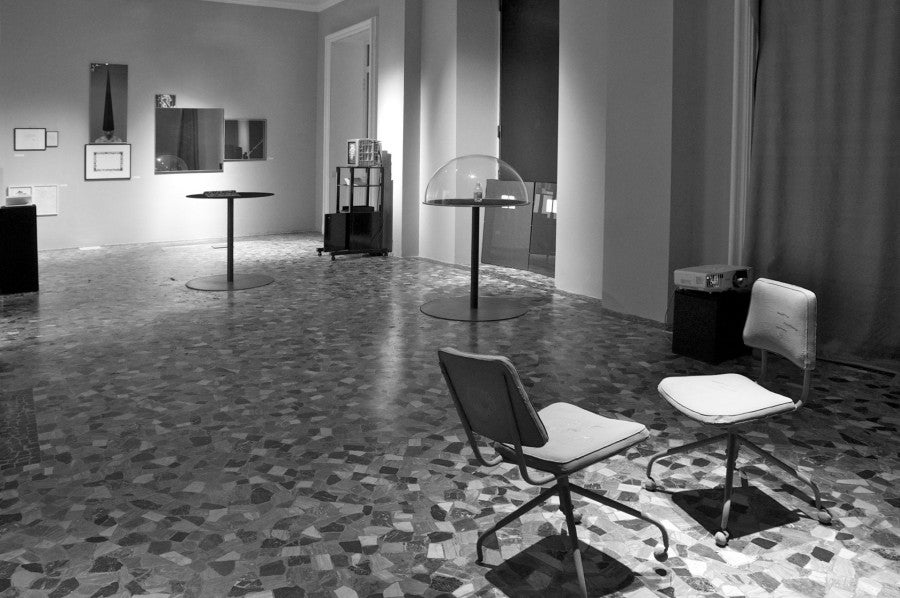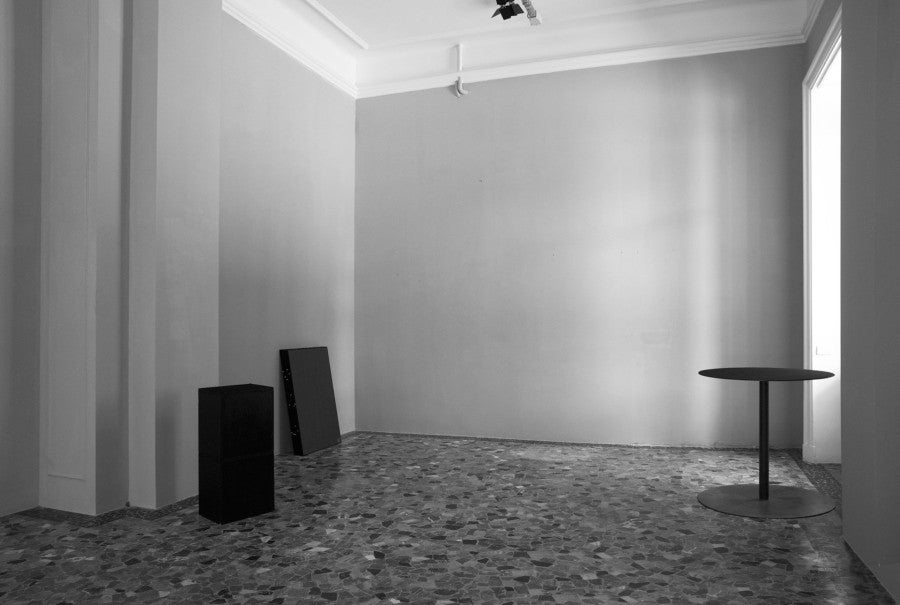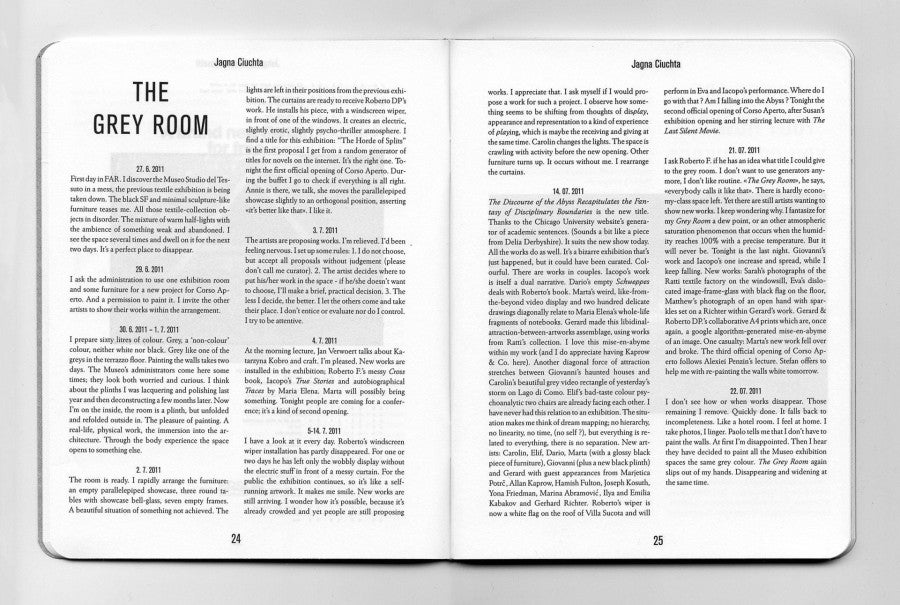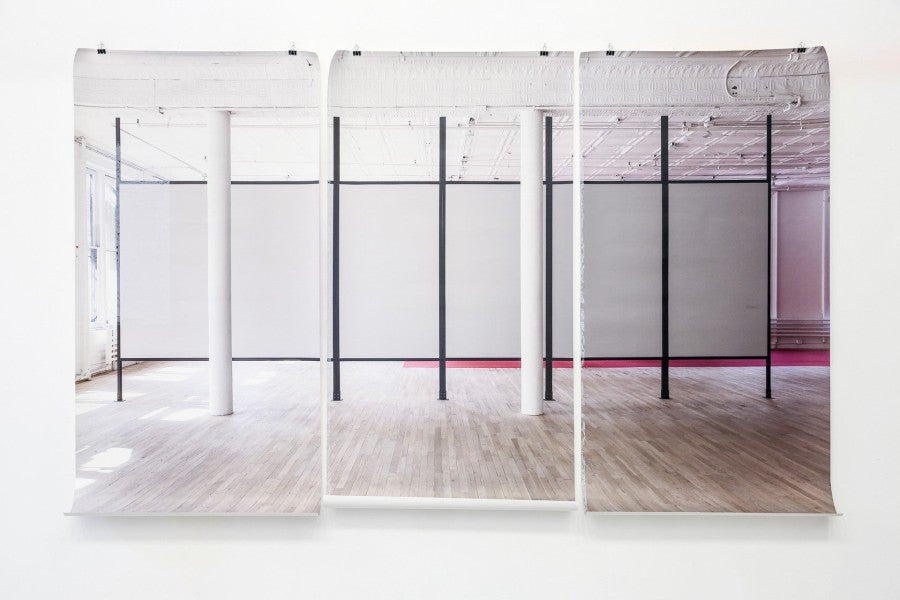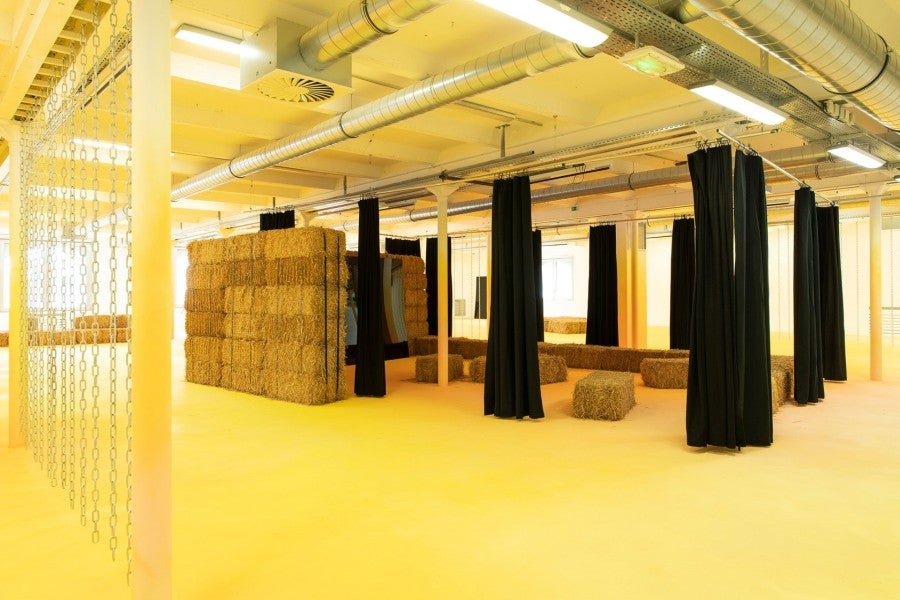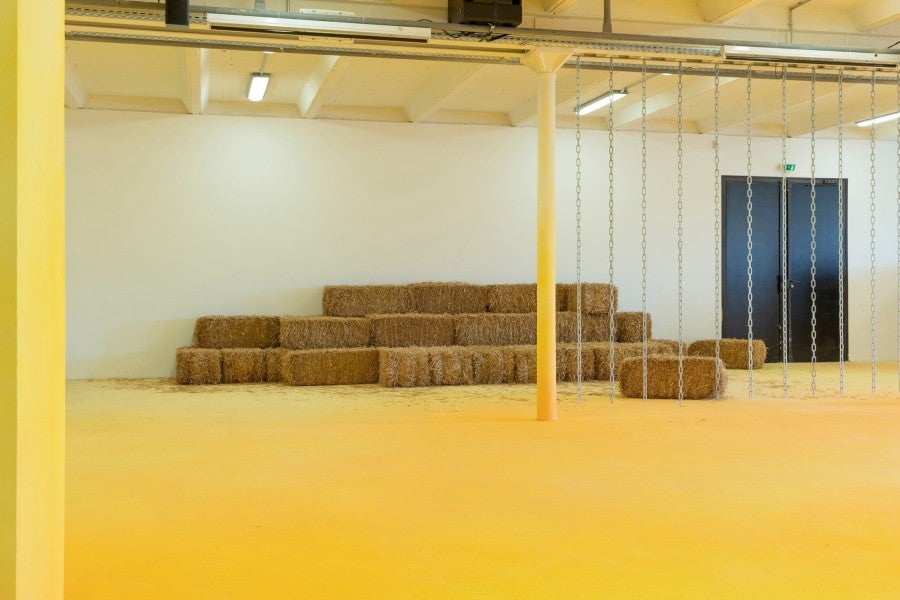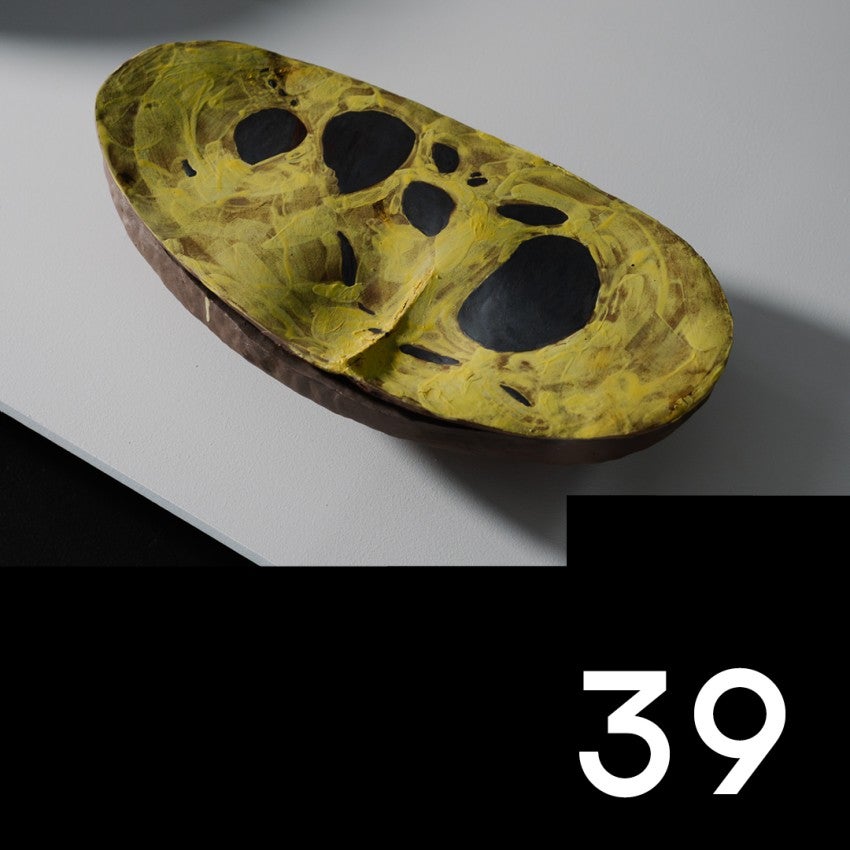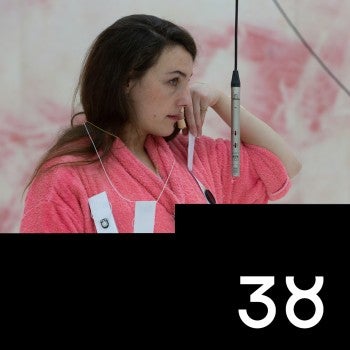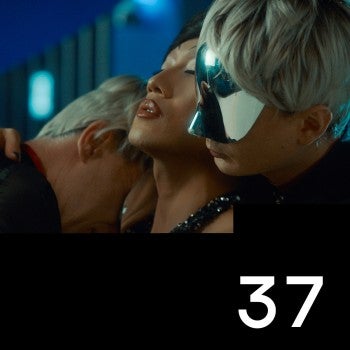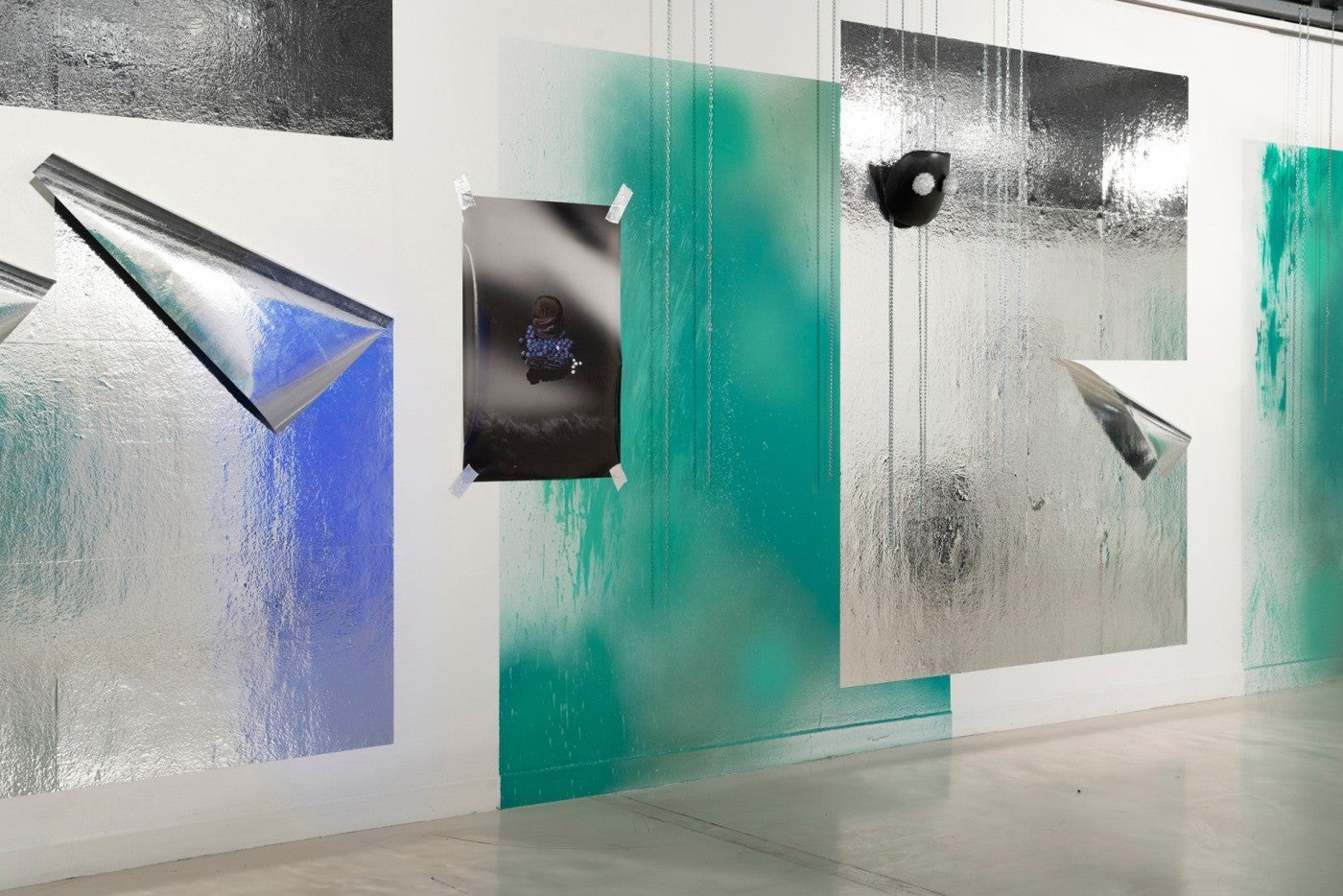
I perceive Jagna Ciuchta’s work as a dynamic system full of instabilities: she is an artist – painter, photographer, installation artist – but also a curator, sometimes a choreographer, at other times a watchful host. Her individual artworks – whether classic large-scale paintings, or more or less experimental photographs, or even the dense installations she arranges – individually fail to capture the nature of her work. Ciuchta seems to be looking for flows and resonances between them, and her strategy seems to be not to settle into any medium, language, or artistic identity: a constant self-occlusion. However, this is not a result of modesty or indecision. On the contrary, this is a deliberate (or rather intuited) strategy to undermine the established divisions, hierarchies, conventions and orders. Precisely in search of these transgressions (not so much rejecting structures as questioning them), the artist has made several strategic decisions which, although subtle, build a kind of continuity and a nomadic, never unambiguous identity of this multi-layered oeuvre. What are these decisions?
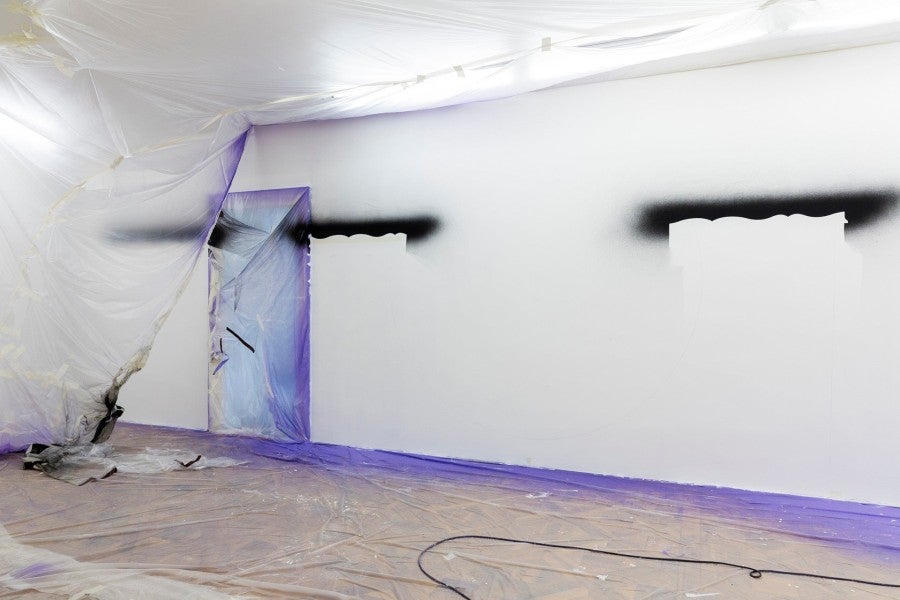
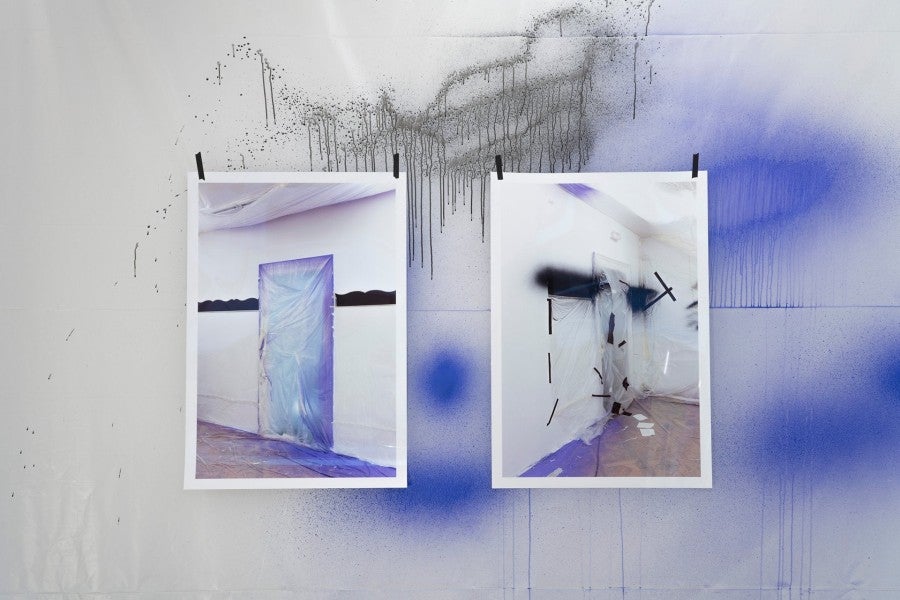
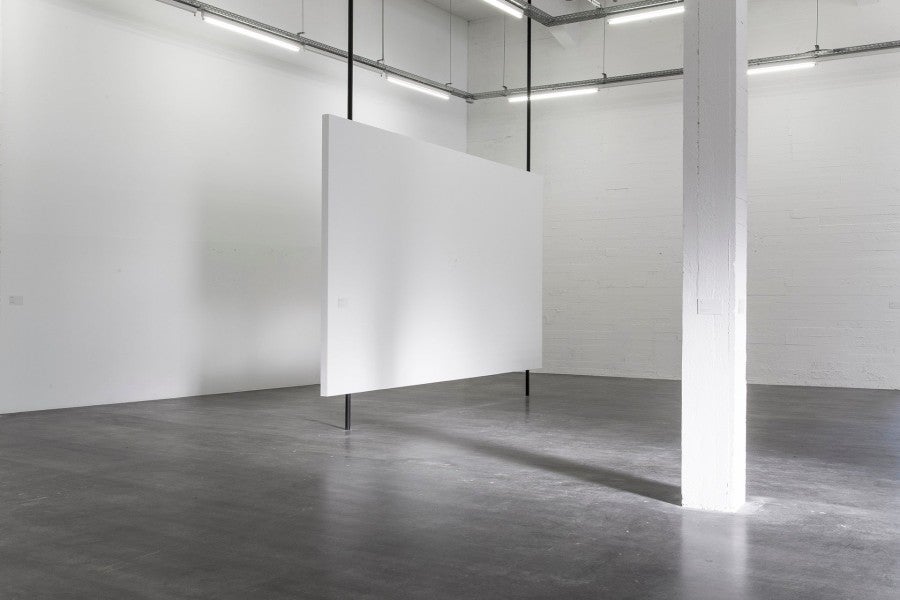
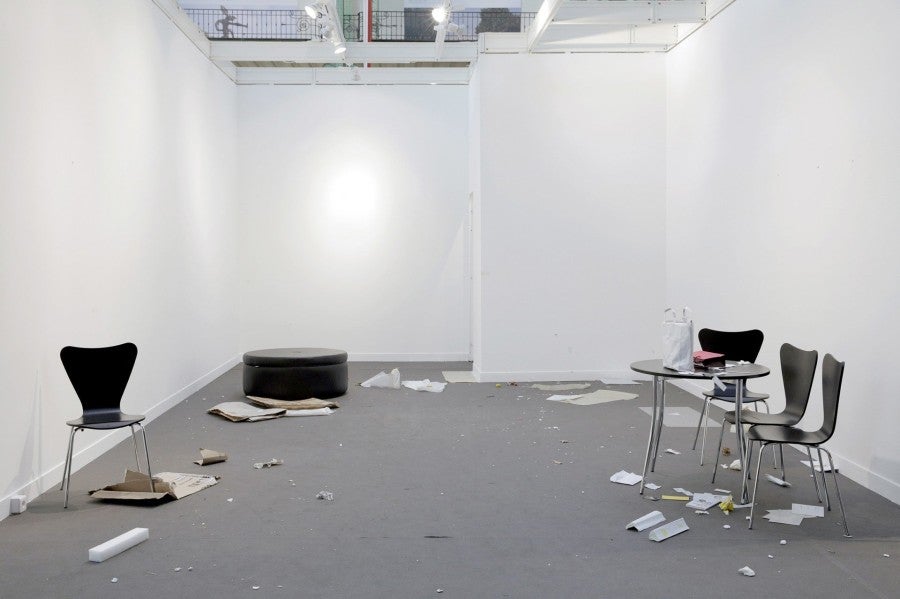
As a young art student, Ciuchta chose to study at the Academy of Fine Arts in Poznań, which she left (in 2001) with a Diploma in painting and a head full of the spirit of contestation and the search for new forms of expression. Her professor, Jarosław Kozłowski, one of the key representatives of conceptual art in Poland, as early as 1971 formulated (in cooperation with curator Andrzej Kostołowski) ‘The NET Manifesto’ which called for the abolition of carefully guarded borders through a free exchange of ideas, projects, artworks, publications, and other forms of expression which would be understandable and accessible beyond the official art circuit. Instead of creating ‘authorial’ or ‘autonomous’ works, the manifesto openly deconstructed myths associated with art (the myth of the artist, of originality, of artistic freedom), for art was defined as the work of the imagination: the ability to throw bridges between one object and another, curiosity about potential relationships – a creative transformation1. This is precisely what his conceptualism was about: more than ready-made, finished ‘works of art’, the artist was interested in the dynamic relationships and movement between objects; in the search for equivalence between different media, vocabularies; in the ways in which art refers to a more or less current social and political situation.
This peculiar archaeology – although undeniably important and formative – does not seem to me particularly necessary in the context of looking for the sources of Jagna Ciuchta’s artistic choices. However, I am interested in it as a dynamic starting point of her migrating art and subsequent series of ‘creative transformations’. There is no doubt that Ciuchta takes over Kozłowski’s conceptual baggage and interest in relations rather than objects, their aesthetic qualities, their aura. Like him, she seems to take a practical view of the imagination: as the capacity (faculté) for combining and constantly reconfiguring meanings, places, spaces and languages. It is the ability – as Baudelaire put it2 – to think both as a poet and as a scientist. It is not without reason that I bring up Baudelaire here. His essay ‘New Notes on Edgar Poe’, referenced above, is an attempt to capture the surrealistic imagination: to think outside hierarchy, outside linearity, and create relationships – often accidental – between elements belonging to entirely different orders. Exactly such a surrealistic ‘loosening up’ of conceptualism seems to me to be a moment when Ciuchta moves beyond the vocabulary of her professor and creatively transforms it. It is a subtle but radical shift. What does it consist of?
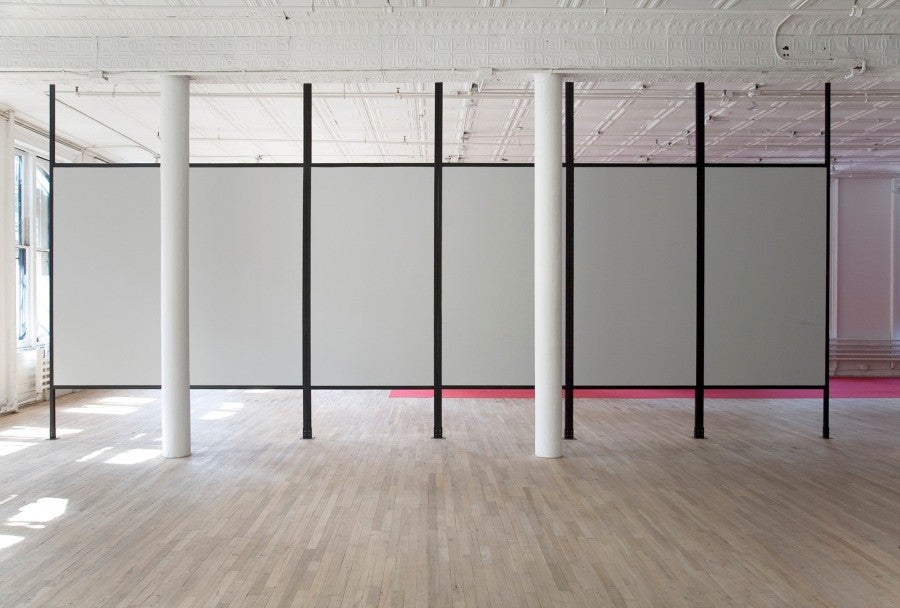
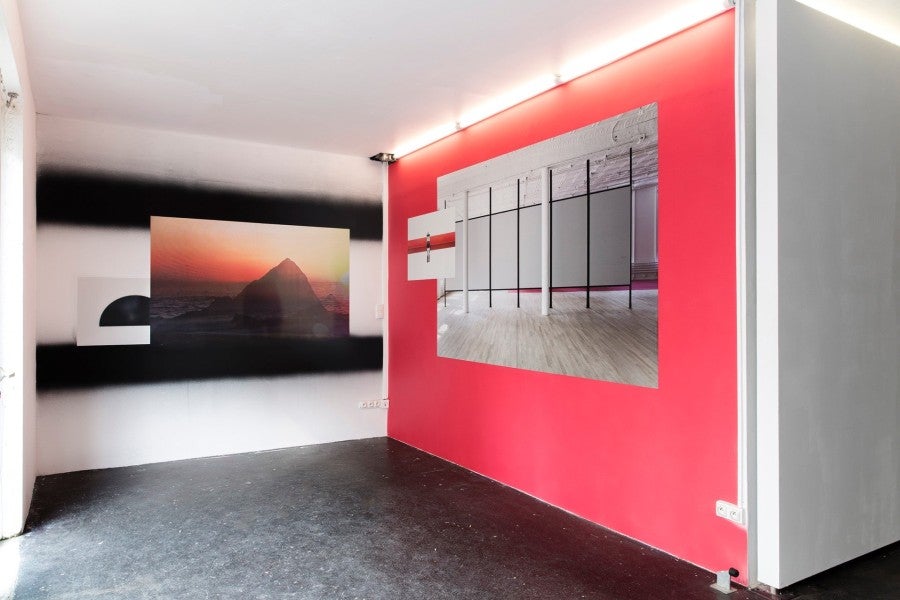
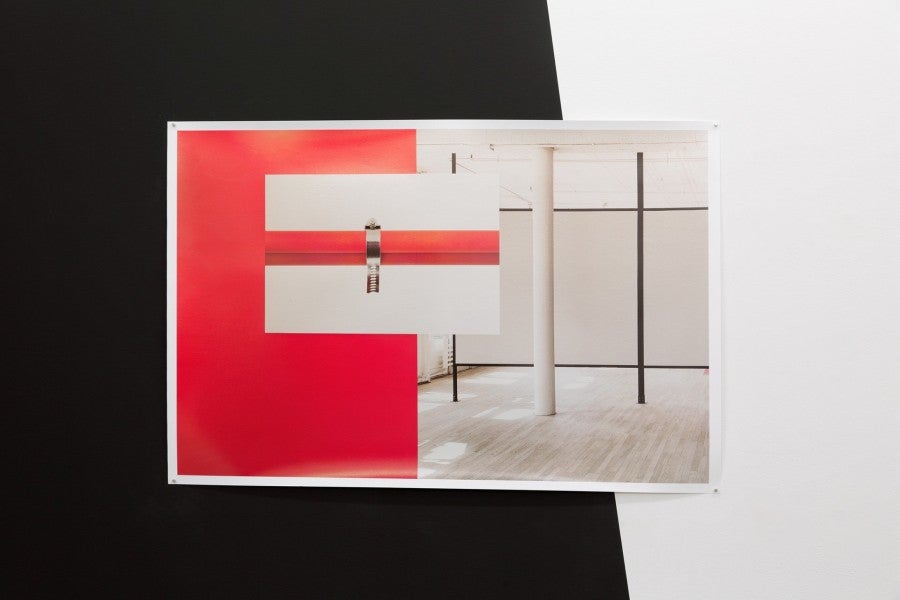
Question of imagination
What kind of strange puzzle is this, where painting becomes sculpture or functions as architecture?
The surrealist imagination, like the conceptual one, is an ability to break and build unexpected relationships. Surrealists, however, unlike conceptualists, were not afraid to withdraw into the shadows and give the field to chance, dreams and/or the unconscious. Their imagination is built from fragments torn out from their universe. These fragments are, for them, the richest source of the much-prized and eagerly pursued incoherences and anachronisms, of all the possible discrepancies, deviations and misunderstandings. Their imagination is a carrier of adventurous and unstable (nomadic), relational and empathic (non-axiomatic) knowledge, and its critical and non-consensual mode of judgment frees it from belonging to any dictionary or norm. This kind of dynamic, sometimes oneiric simultaneity, seems to me to be the main, if not the key, strategy of Ciuchta.
For what else – clearly not indecision – could be the source of this multiplicity of her roles? How to explain the fact that each of her solo exhibitions is always also a group show?3 What kind of strange puzzle is this, where painting becomes sculpture or functions as architecture? Where photography is painted over, and sculpture is an element of a stage design? On what principle and according to what rule do these vectors – inseparable, irregular and never final – work? What is the role of quotation and borrowing in this work, and what do the travelling motifs (fragments) appearing in various contexts, various incarnations and at different stages of her work mean? What does this carelessness (or perhaps it is more the freedom from caring?) about the identity of her own quotations, but also of the works themselves, mean? What does this double leaning mean: from one side toward the previous shows through quotation, and, from the other, toward the future ones through understatement? What is the binder of this swinging work, which is open on all sides? What carries it? Is it centrifugal force (which would it be, since the artist so consistently liquefies all her creations?) or centripetal? What is the underlying poetics, in the absence of any linearity, of any defined aim: a poetics built on a grid of more or less predictable choices, emotions, and series of porosities? What is this heuristic situation, whose principle seems to be the title of one of the artist’s projects: ‘When you see me again, it won’t be me’ (2010)? Can this title be read as her artistic credo?
All these questions bring to mind the caucus-race, as described by Lewis Carroll’s Alice’s Adventures in Wonderland (1865): “they began running when they liked and left off when they liked”.4 It is a race which has no rules except that everyone runs in circles: each player wins and each is given a prize at the end. It is similar to The Lottery in Babylon (1941) by Argentine writer Jorge Luis Borges, a lottery in which all tickets win, and “the number of drawings is infinite”, and “[n]o decision is final, all diverge into others”.5 Do such Caroll or Borges rules offer any instruction? Do they explain anything? Do they make sense or point to any direction? Is it not so that an elementary system is necessary for creating the simplest order?6 What kind of paradoxical logic is at work when images, categories, names, places and all kinds of identities are unable to ‘stay in place’, especially when the common place – a zone of identity that guarantees stability – has fallen apart?7 How to interpret this permanent movement, constantly changing relations, continual transformation? How not to get lost in this newly opened field of discontinuities, this tangle of routes full of secret passageways?
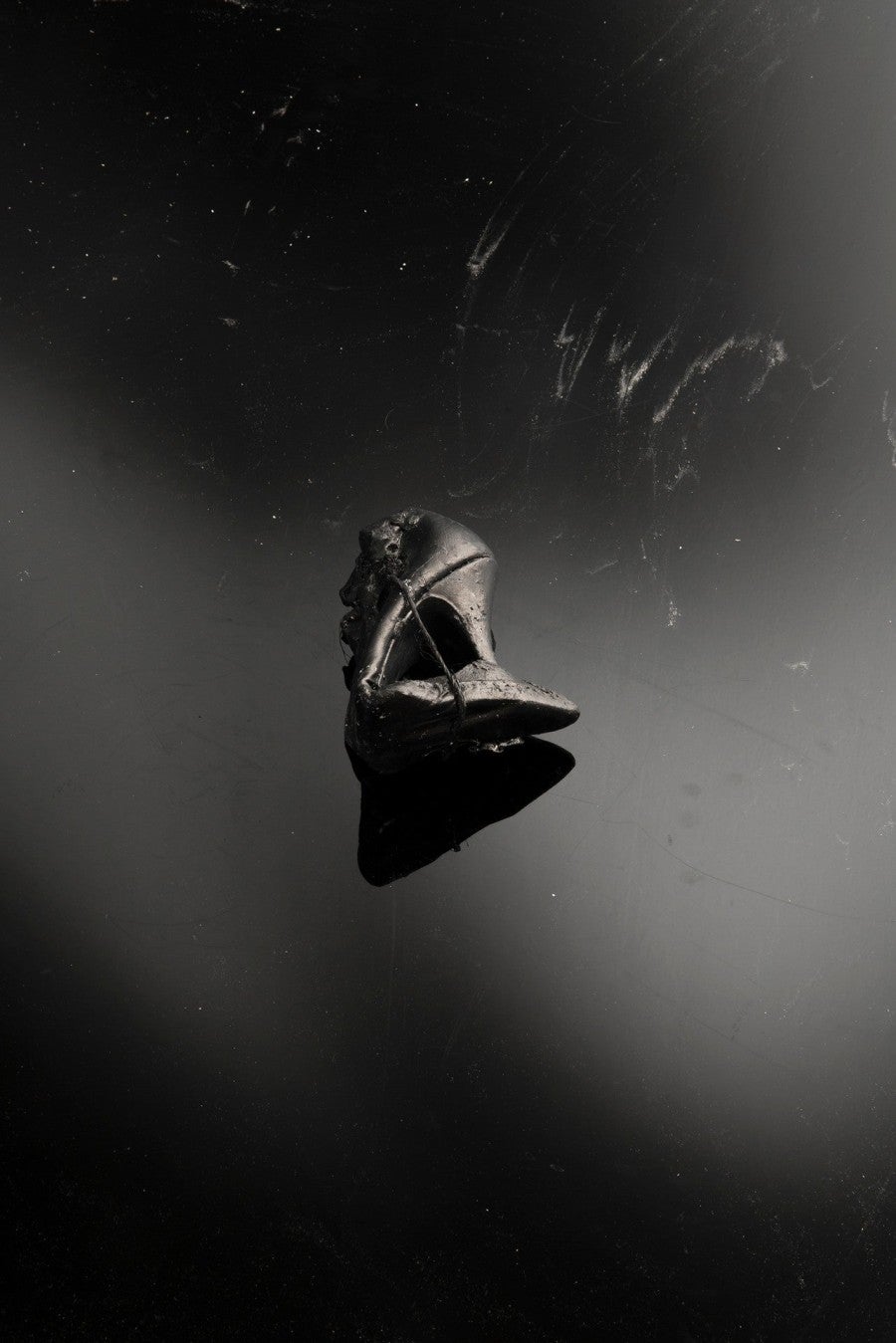
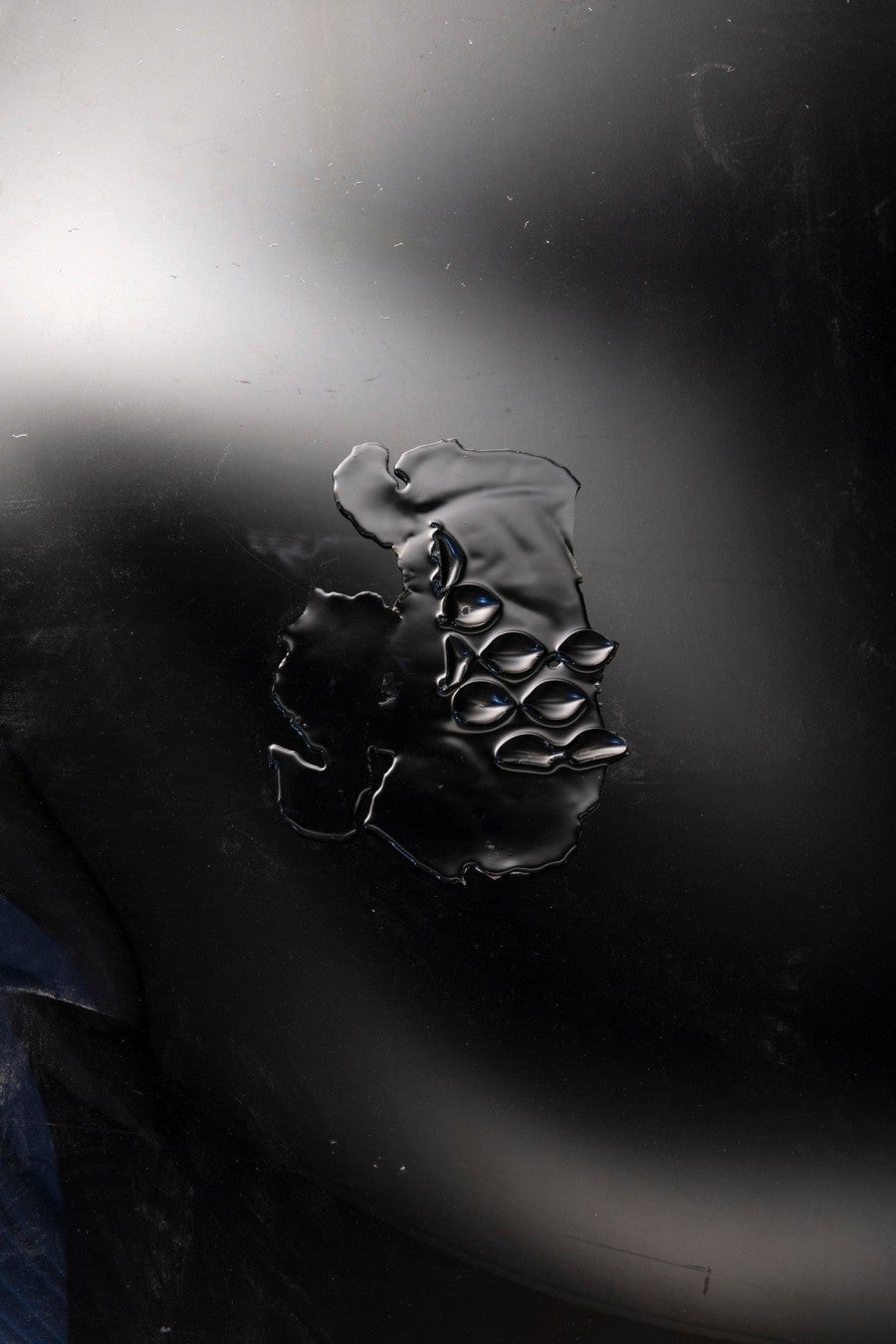
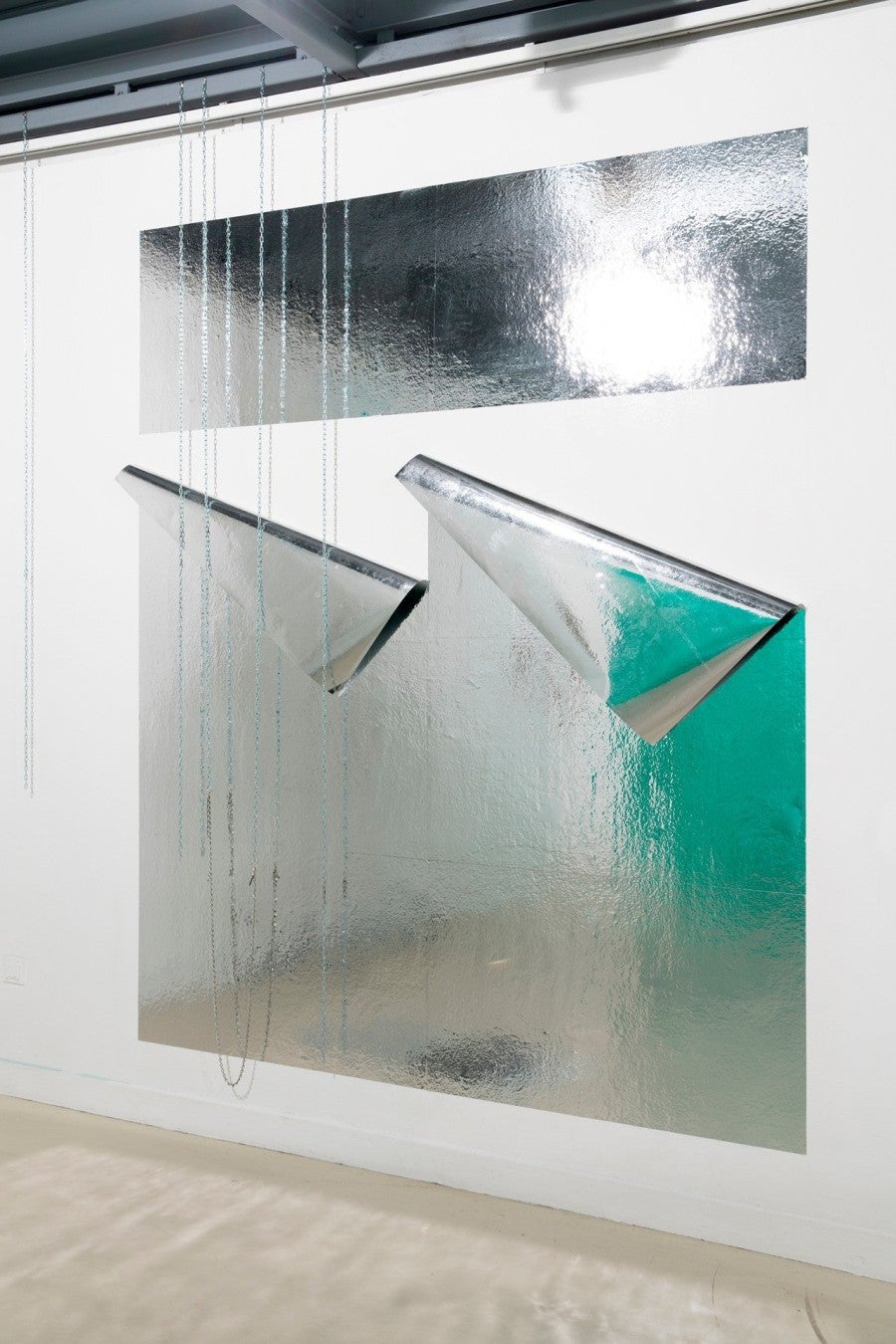
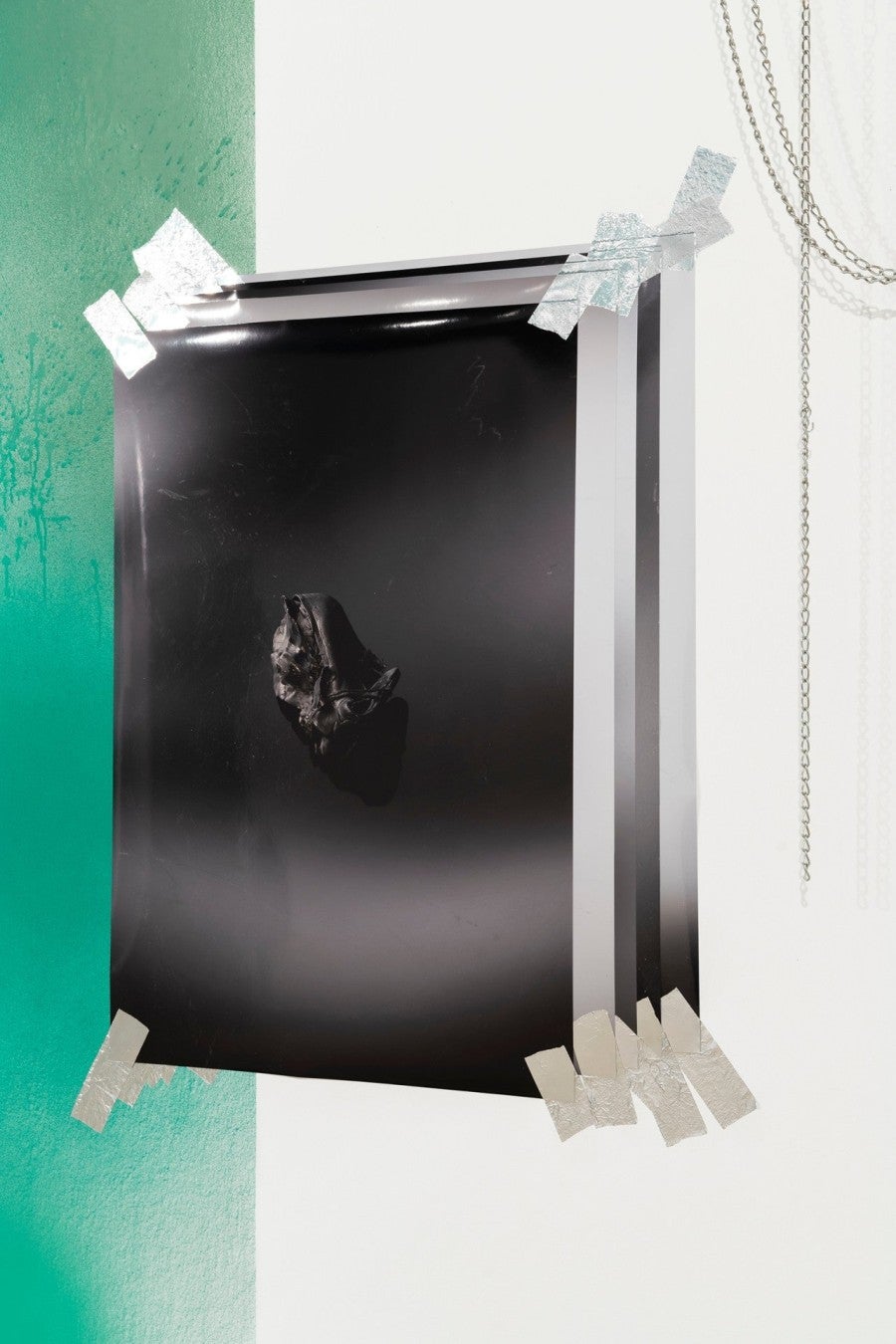
The answer seems to lie in opening up a space of experimentation: starting from details and particulars – a radical activation of existing orders and categories. Gilles Deleuze, in his study on Foucault, writes that paradoxes conceived in this way are often seen as nonsense, where “they are the reality of thought itself”, and consequently “the game reserved for thought and for art… by which thought and art are real, and disturb reality, morality, and the economy of the world”.8 If so, such experimentation is definitely not just innocent play. How telling that in Borges’ The Lottery in Babylon “[t]here are also impersonal drawings, of undefined purpose: one drawing will decree that a sapphire from Taprobane be thrown into the waters of the Euphrates; another, that a bird be released from a tower roof; another, that a grain of sand be withdrawn (or added) to the innumerable grains on a beach. The consequences, sometimes, are terrifying… our customs have become thoroughly impregnated with risk.”9
Series of shifts
I cannot think about her work other than in terms of performance.
The elements listed here, and borrowed from the surrealists10, all resonate with Ciuchta’s artistic choices and strategy – starting with the most basic simultaneity and non-identity, through to unpredictability, inclusiveness, risk-taking, and fascination with the act itself (an experiment here and now). And it is precisely in this context (with all the surrealist baggage described above) that I cannot think about her work other than in terms of performance.
I try to imagine her train of thought – that of a classically trained artist: “Painting? Yes, but it’s too flat, immobilised. Sculpture? Could be, but it’s too linear. Photography? Why not, but it’s too representational. Architecture, stage design? Oh, yes! But it’s too decorative. Curatorial work? Intriguing, but too didactic.” Then she takes them all and ‘cultivates’ them in her own way, more interested in the situations that each of them is able to produce, in the changes and tensions that occur in their course than in a specific, precise effect.11 Moreover, she invites other artists to these situations: an open invitation to an open situation and in this conversation a dynamic, sometimes completely intricate and unpredictable collage is created, which is a kind of testing of boundaries and possibilities of coexistence. This happens in a specific place and time: at an exhibition-event, which is also one of the works in and of itself.
The Grey Room (2011), which the artist realised in Como, Italy in 2011, was an interesting place for oscillating, exploring a field and becoming phenomenologically familiar with a situation: watching it and measuring it. Invited to be part of the ‘Corso Aperto’ programme, the artist, instead of focusing on her piece and inscribing it into a larger or smaller whole, moved away and observed, and in this observation tried to capture the rhythm of the ‘grey room’ filling up. She performed a few introductory gestures – as if she were stretching the canvas or preparing the stage – inviting others, and the object of her observation was not so much their works as the intensities created between them: all the gaps, tensions, more or less expected bridges. She scrupulously noted down all of these observations and her writing took the form of a report. However, it was a subjective report, a note of an engaged observer, curious and intrigued by the improvisation happening before her eyes. “The artists are proposing works” – she wrote on 3 July – “I am relieved. I’ve been feeling nervous. I set up some rules.”12 The next day, “new works are installed in the exhibition: Roberto F. [Fassone]’s messy Cross book, Iacopo [Seri]’s True Stories and autobiographical Traces by Maria Elena [Fantoni]. Marta [Roberti] will possibly bring something”. Towards the end of the month, she wrote: “I ask Roberto if he has any idea what title I could give to the grey room. I don’t want to use generators anymore, I don’t like routine. ‘The Grey Room, he says, everybody calls it like that’”. The show came to an end, the works scattered; what remains is the report: the verbal and photographic documentation.
Isn’t that exactly how performance works and isn’t that exactly the traces it leaves behind? Is this not how its ‘work’ is conceived (in the verb sense)? What actually is its matter? What remains after it?
Artist’s non-choice
There is no doubt that by always taking place ‘here’ and ‘now’ (with all the risk and uncertainties that entails), performance is a time-based medium. Created ‘live’ – as impermanent and interested in the live body and its dynamic performance – it seems to emancipate theatre from the stage, dance from music, and the visual arts from their materiality.13 It is a medium that undermines the stability of those divisions and suspends the classical relationship between the subject and the object, creator and matter. More interested in the process than in the result, in building relations than grasping them in a finite form, performance does not perceive art as a self-sufficient sealed whole but renegotiates this whole continually. Ciuchta does not choose, however, to work with performance, nor even with the likewise dynamic form of dance, or with video’s ‘moving’ image. Neither does she choose to work (directly) with the body (hers or someone else’s). But at the same time, all of her intuitions and choices seem to me to be derived from the universe of performance and the movement she is seeking happens in the places we do not quite expect it.
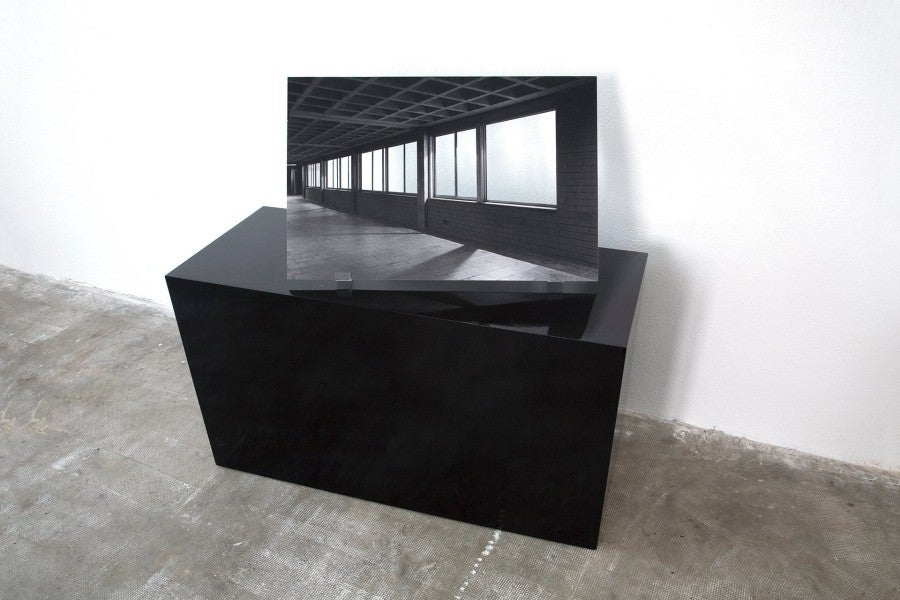
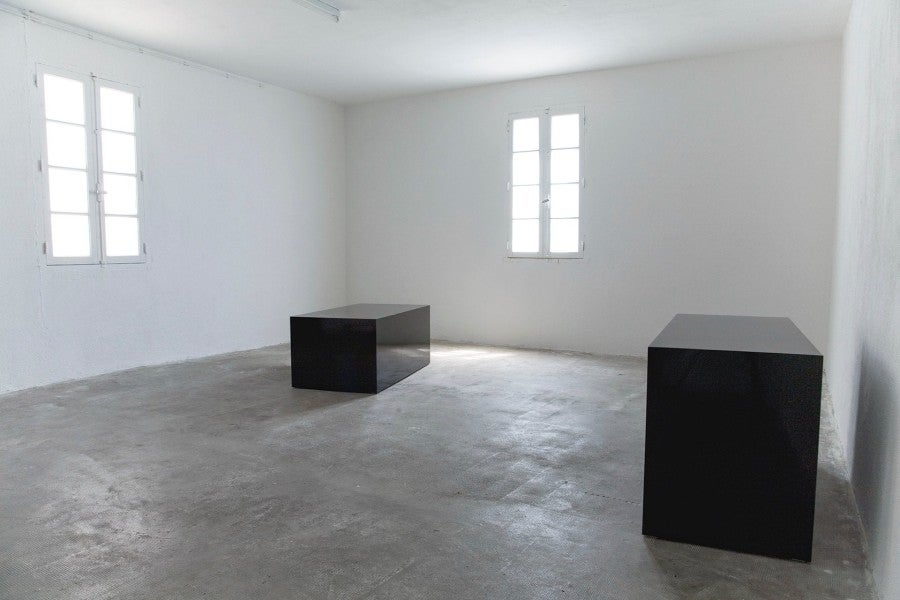
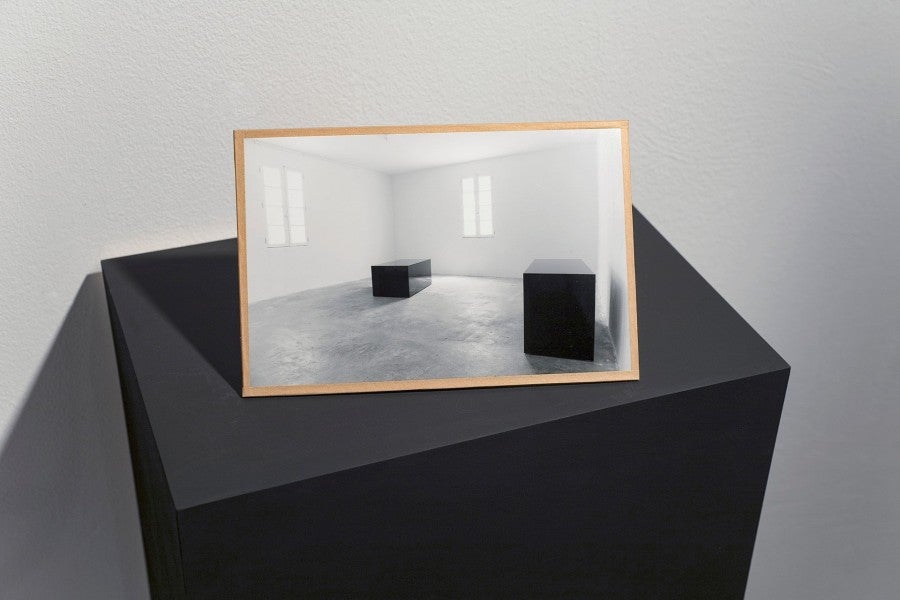
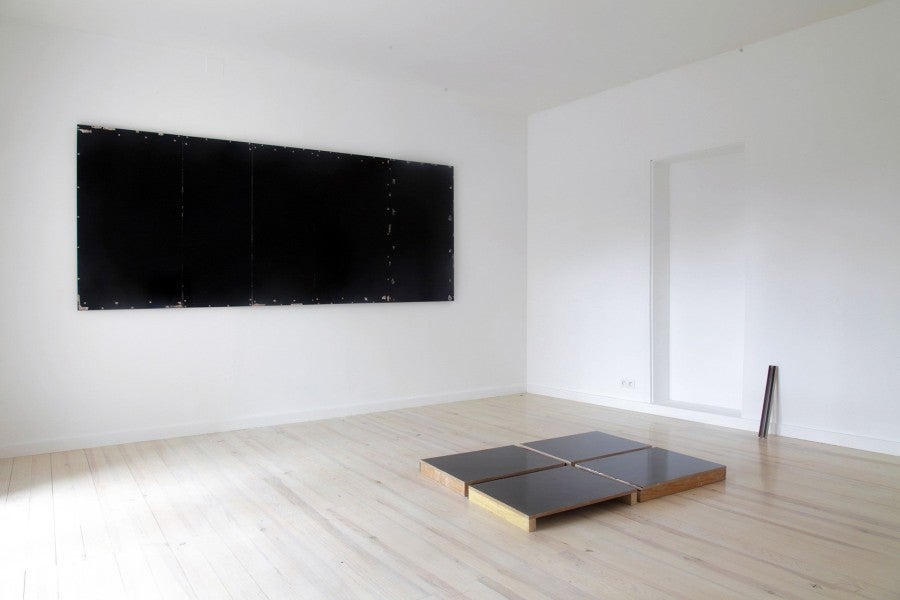
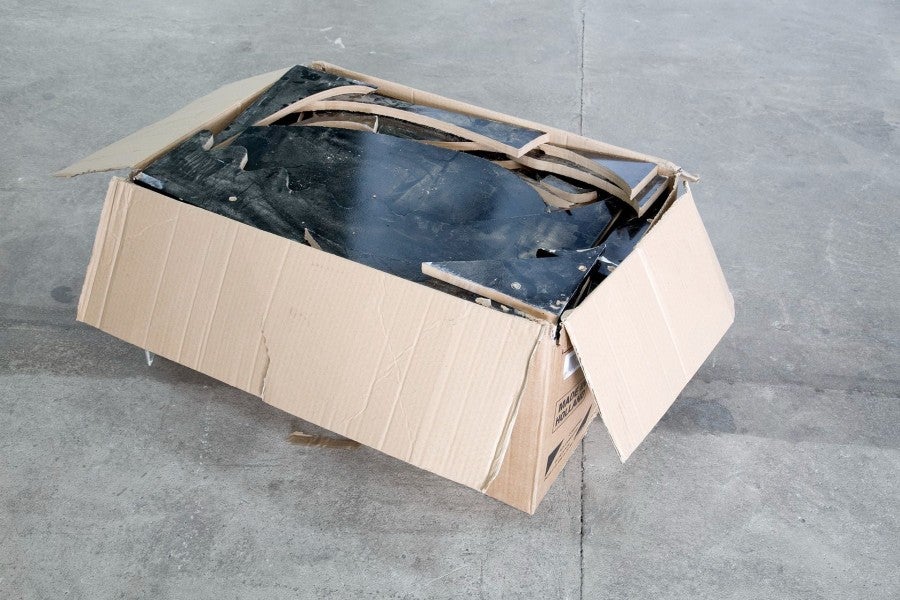
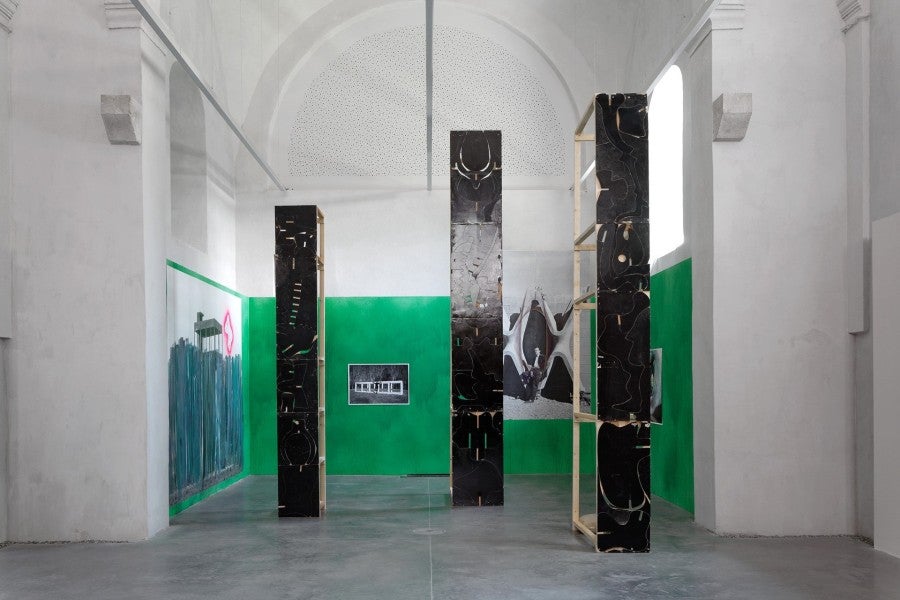
Ciuchta appears to be thinking about this series with a string of ‘mouvements’ of sorts; the exhibition being their residue, the remaining record.
The already mentioned ‘When you see me again, it won’t be me’ seems symptomatic and organises my thinking about Jagna Ciuchta’s work. Spread across several years (2010-15), it is a work/series of exhibitions in which objects undergo transformations, shifts and a peculiar, staggered (de)construction. Exactly in this sense, the subject of this work seems to be movement: movement that pulls objects, formats but also successive incarnations of an exhibition out of comfortable, once established and (re)given identities. The artist is looking for a language to talk about so-conceived flow and original multiplicity in a vocabulary adjusted to it – not so much with ready-made objects and sentences ending with a summary dot, as with a sequence of vacillating situations, a multilayered mise en abyme, which not only deny the identity of their objects (suspended between one incarnation and the next), but in which time is also split. For the wandering motifs, borrowings and artefacts used by the artist – exactly like quotations taken out of context – suspend a simple linearity. Instead of simply developing with time, her sequences are built on a grid that is full of disturbances, stagnations, returns and more or less unexpected shifts. As the artist says about her work, “you will find exhibitions that evolve, either according to a preestablished protocol or guided by the propensity to keep doing or undoing, to displace objects, and to redefine their relationships, leaving the work always endless.”14 Ciuchta appears to be thinking about this series with a string of ‘mouvements’ of sorts; the exhibition being their residue, the remaining record.
Eat the Blue (2013-14) is similarly ‘actively’ composed. The situation built between the bodies/works presented appears, again, as a search for more or less momentary tensions (these works will return to their owners, their authors, after the exhibition), which will be recorded in quite a detailed photographic documentation. The earlier and already mentioned The Grey Room (2011) assumed the active participation of other artists. The movement of works (and their bodies) in the space followed a few organisational guidelines by Ciuchta:
1. I do not choose, but accept all proposals without jugement [sic]… 2. The artist decides where to put his/her work in the space – if he/she doesn’t want to choose, I’ll make a brief, practical decision. 3. The less I decide, the better. I let the others come and take their place. I don’t entice or evaluate nor do I control.15
When it comes to Mélange Doré (2019), it appears to be the next step in this non-chronological sequence. This work (the eponymous mélange) is a cluster of objects and bodies: a work, but simultaneously a (only gently directed) setting, for the presence and spontaneous actions of others.
Is this not a typical situation of improvisation building a leaky framework for an experiment evolving in time? Relying on the active presence and autonomous decisions of living bodies within an ephemeral and impermanent situation, happening only in a specific place and time? Is there anything left after such an improvisation other than one or another kind of record (a note, a series of photographs, an archive of gestures)? Isn’t exactly such dispersion and existence only in documentation inscribed in the nature of performative arts? The artist notes:
Images are often all that remains after the exhibitions, but the documentation is only the beginning of the journey. Image-document, image -work, image -medium, image -waste. Some of them cease to be documentary images and emerge in other exhibitions. They then either become the background for other images and objects or are themselves artworks hung on new background paintings. Relocated, extracted again from their original context, taken off the walls, combined or incorporated, such residues of exhibitions acquire a new status and new caption, always remaining an archive of themselves and of what they represent. They are liquid images as they flow from one exhibition to another, slide from one medium to another, leak from one state into another.16
I cannot read this other than as a situation of additionally open documentation, activated once again. That is, an ongoing performance.
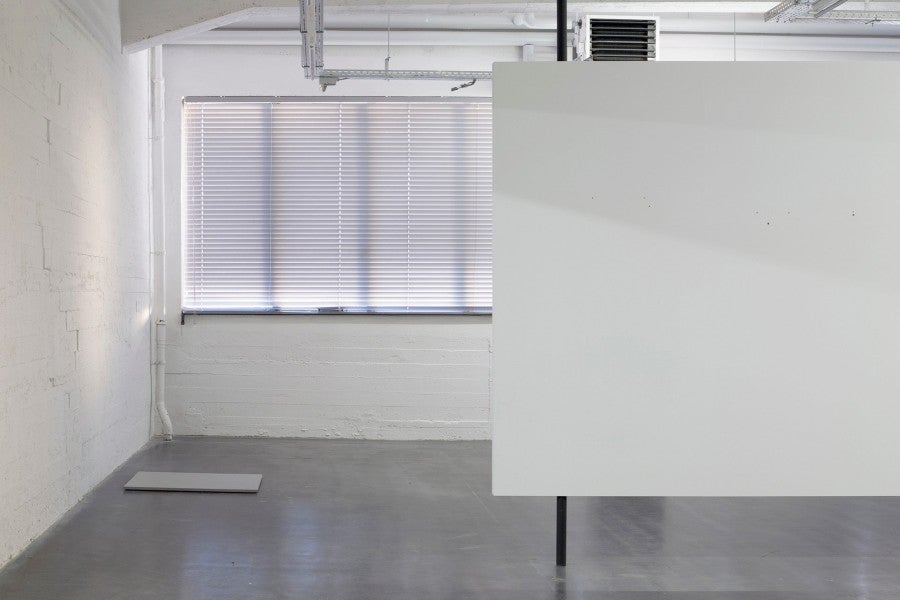
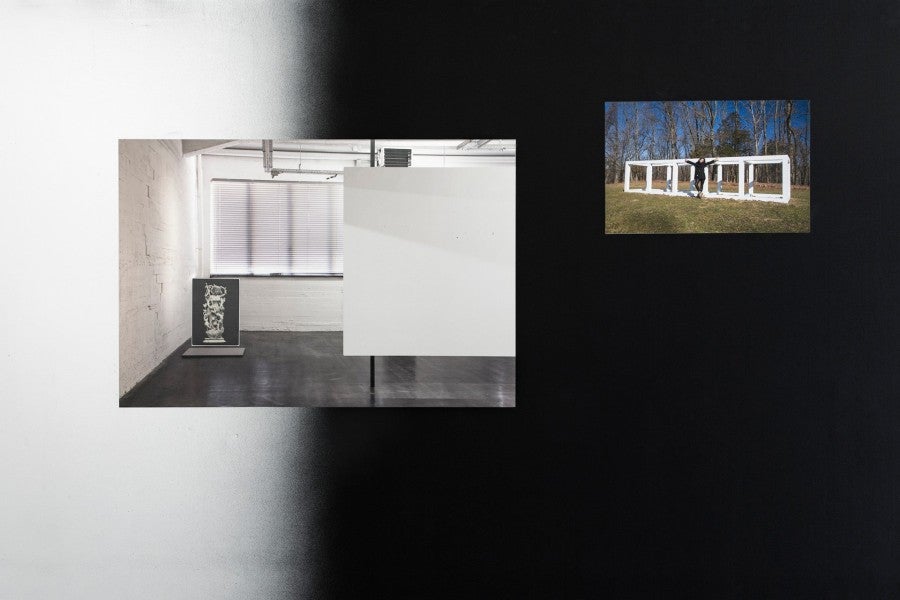
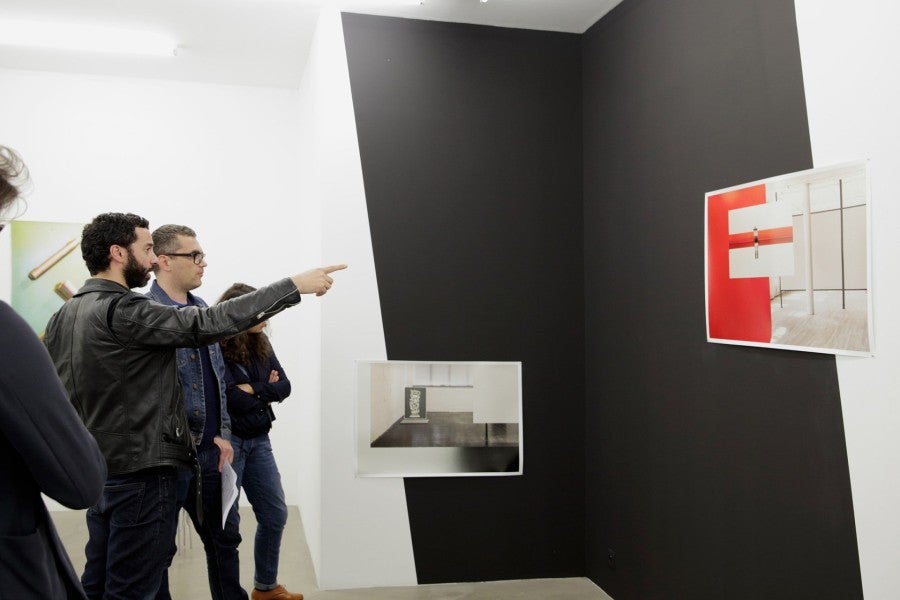
...art is for her a kind of laboratory in which she imagines (in the sense given to the imagination by the surrealists), explores and tests other (soft) models of making, sharing, perceiving, or ultimately living.
When, during one of our conversations, I asked Ciuchta whether what she does – building ‘live’, inclusive situations; observing the dynamic of relations and the transformations that happen within those relations; multi-level exchanges and transpiring affects – could be expressed (by her) in a completely different discipline, she replied that it definitely could. Evidently, however, art is for her a kind of laboratory in which she imagines (in the sense given to the imagination by the surrealists), explores and tests other (soft) models of making, sharing, perceiving, or ultimately living. “One must introduce in the diagnostic of our times,” says Peter Sloterdijk in La Mobilisation infinie (2000), “a kinetic and kinesthetic dimension because, without such dimension, all discourse about modernity will completely bypass that which in modernity is most real”.17 There is no doubt that performance is the medium that is most strongly associated with the very acute occurrence of a multidimensional, nomadic and radically unstable experience of being in the world today. This is how I read Ciuchta’s time-evolving performance. Using it, she creates an artistic/utopian non-place, which is simultaneously extremely concrete, real and situated in time. Alongside this, she is interested in process and movement and these seem to be the heart and motor of her entire practice.
Kozłowski’s conceptualism worked in this very mode: imagination and ‘creative transformation’ were for him the means to overcome the abyss between the concept and its visualisation.
Charles Baudelaire, ‘New Notes on Edgar Poe’ in: Baudelaire as Literary Critic. The Pennsylvania State University Press, 1964, 127.
The problem of subjectivity and identity in Jagna Ciuchta’s work is quite intricate and could probably be the subject of a separate study. Ciuchta incessantly mediates and stratifies: the act of creation is, for her, the act of co-creation (she invites other artists – both professional artists and amateurs – to help author her work and she includes the work of others). The question one should pose in this context would concern the border between co-creation and (artistic) appropriation, but such inquiry is beyond the scope of this text.
Lewis Caroll, Alice’s Adventures in Wonderland & Through the Looking Glass, Signet Classic, 2000, 53. (It is worth noting that in 1969 none other than one of the most famous surrealists, Salvador Dali, illustrated this amazing book with his unique heliogravures).
Jorge Luis Borges, Ficciones, Grove Press, 1965, 70.
Michel Foucault, The Order of Things, Routledge, 2005, xxi.
Ibid., xix.
Gilles Deleuze, Logique du sens, éd. Les Editions du Minuit, Paris, 1969, 76; quoted after Georges Didi-Huberman, Atlas: How to Carry the World on One’s Back?, Museo Nacional Centro de Arte Reina Sofia, Madrid, 2011, 54.
Borges, op. cit., 70.
Jagna Ciuchta’s L’un dans l’autre, 2017, refers to and borrows its title from the work and gesture of Toyen (born Marie Čerminowa, 1902-1980), a Czech-French representative of surrealism.
Consciously taking the risk of the potential accusation (not unfounded) of outsourcing and appropriating, as mentioned in footnote 3.
All of the quotations related to this work are from: The Grey Room, Jagna Ciuchta in Wolves and Peasants 38% Notes 38% No Title 19% Dreamers 4%. Fondazione Antonio Ratti, Mousse Publishing, 2011, 25.
Solipsism, stasis, linguistic materialism, the (doubtful) authority of the author, representationalism, and reification seem to be the starting point for the medium of performance which emancipates itself from them.
Jagna Ciuchta, Thesis portfolio, Expositions ; je dilaté, images liquides et plantes carnivores, 2014-2019, 9.
The Grey Room, ibidem.
Jagna Ciuchta, Thesis portfolio, ibidem.
Peter Sloterdijk, La Mobilisation infinie, Christian Bourgeois Editeurs, Paris 2000, 27.
